|
Art
/ History / Biography / Stories of Man/Boy Love
|
|
|
Wilhelm von
Gloeden
First
great photographer
of the male nude
|
|
by Peter Young
|
THIS
IS A STORY of courage in the face of oppression, about
a man who had
faith in his desires and the fortitude to live the truth. This is
also a story of the evolution of a modern art form, and of a particular
ideal of homoeroticism that unleashed a torrent of creativity in a man
who might otherwise have dissipated his life.
Wilhelm von Gloeden lived
heroically. He knew what
he was and was
proud. Like Oscar Wilde before him, von Gloeden lived in
dangerous defiance of an age and a Christian society that hounded and
tortured men of his kind. As Charles Leslie writes:
He was one of those rare nineteenth century
men
who would not accept the destruction of his true being as the price for
being allowed to survive in an allegedly civilized Western world that
officially despised what he was. In his own way he triumphed, and
therefore became one of those figures who, to this day, stand as models
for people who dare to live the truth of what and who they are. 1
Von Gloeden was born near Wismar,
Germany, on September 16,
1856. His father, a wealthy Baron, died when Wilhelm was just a
boy. His stepfather, also a Baron, was a counselor and friend to
Kaiser Wilhelm. Von Gloeden was classically educated in the
highest circles of the Prussian elite. But Wilhelm had no
interest in politics. Instead he gave himself over to art and
aesthetics. The study of ancient civilizations was then more
popular than at any time since the Renaissance, and Wilhelm became a
student of antiquity. But his ability to sketch and paint was
impaired by tuberculosis, at the time one of Europe's great
scourges. Still in his early twenties, Wilhelm was advised by
doctors to seek a warmer, drier climate. A chance meeting in a
beer garden gave Wilhelm the idea of going to Sicily.
The advent of modern transportation was giving birth to tourism.
Though at this point it was still the province of the relatively
wealthy, never had so many people been able to experience the sights
and sounds of foreign lands. von Gloeden happened to meet a
fellow Baron, some years his senior and a fellow painter, who had
recently returned from Taormina, a sea town on Sicily's east
coast. The Baron was now a one-man chamber of commerce to bring
visitors and their money into the poor town. Such were his powers
of persuasion, and such were Wilhelm's wealth and freedom, that within
days, all arrangements had been made. Shortly, Wilhelm was off to
the land which (except for a short time during World War 1) he would
never leave.
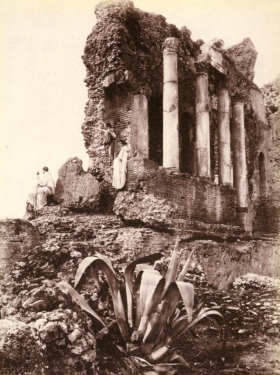 THE ANCIENT TOWN of
Taormina sits high above the sea. Originally
a Greek outpost, then a Roman possession, Taormina hangs between the
sky and the transparent blue Mediterranean with breathtaking panoramas
of the rugged coastline. Snow-capped Mount Etna hovers in the
distance. The remains and influences of the previous
civilizations -- the Greek amphitheater and columned temples, the Roman
aqueducts still providing water -- are everywhere. Above all,
there are the people themselves, with their beautiful mixture of Greek,
Roman, and Arabic features. THE ANCIENT TOWN of
Taormina sits high above the sea. Originally
a Greek outpost, then a Roman possession, Taormina hangs between the
sky and the transparent blue Mediterranean with breathtaking panoramas
of the rugged coastline. Snow-capped Mount Etna hovers in the
distance. The remains and influences of the previous
civilizations -- the Greek amphitheater and columned temples, the Roman
aqueducts still providing water -- are everywhere. Above all,
there are the people themselves, with their beautiful mixture of Greek,
Roman, and Arabic features.
On the day Wilhelm arrived in Taormina, the son of a burro driver -- a
handsome youth of sixteen or seventeen -- was assigned to him to act as
a guide. Wilhelm kept the boy with him the whole day, and, as
fate would have it, for most of the night. Stretched out together
on the uppermost tier of the ancient Greek theater, they talked and
laughed and watched the brilliant Mediterranean stars above.
Later, they lay together in the warm meadows of Monte Ziretto with the
sound of summer cicadas singing in the cool of pre-dawn. This was
the start of what Wilhelm called his long starry-nighted ecstasy, a
delirium of carnal and spiritual rapture.
A villa was quickly purchased, and a staff hired to run it.
Thirteen- or fourteen-year-old Pancrazio Bucini was chosen to be the
houseboy. A darkskinned lad with large eyes, Wilhelm gave
Pancrazio the nickname "Il Moro" -- the Moor. Wilhelm's affection
for Il Moro grew rapidly and was returned. The youth tended to
Wilhelm's illness: administering medications, bargaining with the
townspeople for special restorative foods, preparing the warm salt
water baths prescribed by the doctors, and arranging for many local
youths to participate in the midnight revels that Wilhelm offered his
house guests. Il Moro was not just a servant but a much-loved
friend and ally. He would stay on as Wilhelm's personal assistant
for the rest of Wilhelm's life, and became the heir of his photographic
legacy.
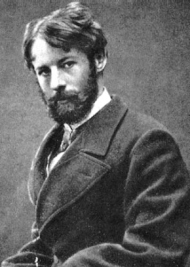 THOUGH ILL,
von Gloeden
retained his immense charm, which attracted to
him ordinary people, as well as those closer to his rank and
background. Everyone agreed that his company was a pleasure, and
he soon was called to happily by the townspeople as "Gugliemo," the
Italian equivalent of William. He made no attempt to conceal from
the citizens of Taormina what he was -- a practicing homosexual in a
time of strong societal intolerance. He believed that human
sexuality was to be enjoyed, and made this belief manifest in the way
he lived his life. His life harmed no one. People were
never coerced into doing anything that they did not wish to do, and von
Gloeden never prescribed sexual conduct for anyone. The
townspeople chose to ignore Wilhelm's midnight orgies, even though they
involved their own sons. They loved him as a kind, reliable
friend -- a giver of employment when money was sorely needed, and one
who touched their ordinary lives with the class of rank and intimate
graciousness. When a local family had a setback, Wilhelm would
often invent some work to be done in order to justify a gift of aid,
which would not be otherwise accepted by the proud people. He
secretly provided dowries for daughters of poor families whose
potential husbands were young men of whom Wilhelm was fond. He
would later establish a system of accounts which provided funds,
"royalties," to the boys who posed for his camera. The money
allowed many young men to start businesses or purchase boats with which
to earn a living, or seek an education in the city. Many
Taorminese families owe their present level of prosperity to a
grandfather or great uncle who modeled for von Gloeden. THOUGH ILL,
von Gloeden
retained his immense charm, which attracted to
him ordinary people, as well as those closer to his rank and
background. Everyone agreed that his company was a pleasure, and
he soon was called to happily by the townspeople as "Gugliemo," the
Italian equivalent of William. He made no attempt to conceal from
the citizens of Taormina what he was -- a practicing homosexual in a
time of strong societal intolerance. He believed that human
sexuality was to be enjoyed, and made this belief manifest in the way
he lived his life. His life harmed no one. People were
never coerced into doing anything that they did not wish to do, and von
Gloeden never prescribed sexual conduct for anyone. The
townspeople chose to ignore Wilhelm's midnight orgies, even though they
involved their own sons. They loved him as a kind, reliable
friend -- a giver of employment when money was sorely needed, and one
who touched their ordinary lives with the class of rank and intimate
graciousness. When a local family had a setback, Wilhelm would
often invent some work to be done in order to justify a gift of aid,
which would not be otherwise accepted by the proud people. He
secretly provided dowries for daughters of poor families whose
potential husbands were young men of whom Wilhelm was fond. He
would later establish a system of accounts which provided funds,
"royalties," to the boys who posed for his camera. The money
allowed many young men to start businesses or purchase boats with which
to earn a living, or seek an education in the city. Many
Taorminese families owe their present level of prosperity to a
grandfather or great uncle who modeled for von Gloeden.
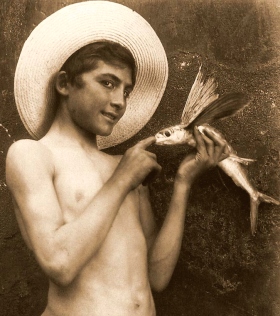 Von Gloeden was in love with
the youths of Taormina, and by extension
with the Sicilian people as a whole. His love of boys was shared
not only by his high ranking friends who visited with great frequency,
but also by the two powerful Catholic priests who served the
region. He and his youths had constant access to the great homes
of the priests, as settings for photos by day and for marathon sexual
revels, with the priests as participants, by night. Von Gloeden was in love with
the youths of Taormina, and by extension
with the Sicilian people as a whole. His love of boys was shared
not only by his high ranking friends who visited with great frequency,
but also by the two powerful Catholic priests who served the
region. He and his youths had constant access to the great homes
of the priests, as settings for photos by day and for marathon sexual
revels, with the priests as participants, by night.
As Wilhelm's health improved, he sent for his sister, Sofia Raab,
who
assumed the role of hostess for the constant stream of visitors.
Sofia was beautiful and intelligent, but chose to remain unmarried --
possibly due to an earlier love lost. The word of Wilhelm's
scandalous revels had by now reached as far as St. Petersburg and
New York. Sofia did not object to Wilhelm's choice of affections,
so long as Wilhelm was happy. And happy he was indeed. But
it was not to last.
VON GLOEDEN'S STEPFATHER,
the Baron, had angered the Kaiser by printing
an account of a secret meeting with foreign officials. The state
confiscated the Baron's estate and all his possessions, and would have
locked him in prison for life had he not been able narrowly to escape
capture. He fled to Greece, unable to join Wilhelm in Sicily
since the Kaiser had agents who would seek him out and have him
killed. Wilhelm now found himself with no source of income, his
regular remittance cut off by the Kaiser. He considered
journeying to Germany to plead his case, but decided -- wisely -- that
this would be too risky of a venture. He had no choice but to let
go his staff of servants, even Il Moro. But the youth refused to
leave. Saying that he had been with Wilhelm in riches, he would
now stay with him in poverty.
Von Gloeden now had the revelatory experience of learning about the
true nature of friendship. The wealthy friends who had numerous
times accepted and enjoyed Wilhelm's hospitality simply vanished.
But when things were at their worst, when there was no food for the
"family" -- Wilhelm, Sofia, and Il Moro --there would appear a couple
of freshly-caught fish, a loaf of home-made bread, a basketful of eggs
or vegetables. These were homages from the ordinary people of
Taormina, who did not forget the generosity and kindness of "Il
Barone.” Il Moro did odd jobs provided by the townspeople, just
as Wilhelm had done for them, in order to obtain a little spending
money.
Around this time, a boyhood friend of Wilhelm's, Duke Friedrich Franz,
heard of the plight of his old friend and began sending money secretly
(for to do so openly would be dangerous). Wilhelm was not used to
accepting aid. The Duke requested that as payment, Wilhelm was to
send sketches, paintings, and photographs of the beautiful
island. He then sent the most inspired gift of all -- an immense
view camera from Berlin. von Gloeden began photographing every
example of antiquity and every scenic viewpoint, with Il Moro at his
side to carry the heavy equipment and to help run the darkroom and
laboratory. Wilhelm had been introduced to photography by his
cousin Wilhelm Pluchow in Naples. Wilhelm soon added photography
to his talents as an artist and painter.
WE TODAY must make a
visual and spiritual adjustment when looking at
the photographic past; we've been exposed to captured images all our
lives, but to the public at that time, photography was entirely
new. Only with this in mind can we understand the achievement of
Wilhelm's art. von Gloeden's exquisite compositional formality --
perfectly conveyed even in postcard size -- led to the sale of prints
by the thousands around the world. Learned groups from all over
Europe used von Gloeden's prints to illuminate the ambiance of the
ancient world, and his pictures were turning up in albums on parlor
tables in London and New York. Photography sales provided Wilhelm
with the money to resume his former lifestyle, which naturally included
the resumption of the legendary orgies. And so, the stream of
house guests began once again.
But Wilhelm was not content to photograph the natural scenery. He
wanted to capture and share his own private view of heaven with his
cultured friends (and fellow homosexuals) around the world. With
a clearly defined aesthetic and a sure sense of his own artistry, von
Gloeden abandoned scenic postcard photography to become the foremost
proponent of a kind of purely pictorial photography which, for its day,
was revolutionary.
Using photography for personal artistic expression now seems a natural
extension of the medium. But at that time, "real" artists derided
or ignored this form of photography. 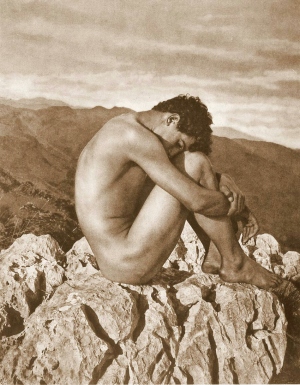 By 1887, critics and public
alike began to understand true pictorial photography -- photos with
which the photographer was trying to relate a feeling or a story.
People began buying large prints to hang in their homes. By 1887, critics and public
alike began to understand true pictorial photography -- photos with
which the photographer was trying to relate a feeling or a story.
People began buying large prints to hang in their homes.
Von Gloeden used as settings for these photographs the town square, the
large terraces overhanging the Ionian Sea, gardens of magnificent
villas, convent and monastery courtyards, and every manner of prop and
location that would create a mood of Greek antiquity. Beautifully
composed, von Gloeden's photographs transformed working-class boys into
images of antique legend. Many photographs held the image of two
or more boys, or a young man with a younger boy, and had the ability to
suggest mysterious and unknown relationships. Some photos show
girls who are, in fact, boys dressed as girls. The positioning of
the models and their facial expressions hinted at subtly suggestive
relationships, and many related a strange processional or ritual
quality. The explicit nudity was intended to be seen only by
Wilhelm's close friends, while the chaste "classical Greek" postcards
were intended for sale in local shops. (These were to become
enormously popular with tourists and became famous worldwide.
American painter Maxfield Parrish, for example, owned many von Gloedeh
studies, and his paintings strongly suggest von Gloeden's influence.)
Even the explicit nude photos were accepted and often cherished by the
ordinary townspeople of Taormina whose sons and brothers were their
subjects. Likewise von Gloeden's wealthy and educated friends
could not keep secret the beauty of his Greek vision. They spread
the word and von Gloeden found himself becoming famous and wealthy once
again from his work, for which he initially had no desire nor hope of
profit.
Von Gloeden's photo laboratory became busier and busier. Many of
the world's famous photographers were attracted to him -- requesting to
learn new techniques. Around this time, von Gloeden developed an
emulsion of milk, olive oil, glycerin, and scent which he used on the
models to give their skin a soft, even glow. He pioneered the
field of filters and of transparent colors brushed directly onto
photographs, which subtly altered the tonalities and intensities of the
finished print. Many more assistants (who doubled as models) were
hired and were supervised by Il Moro, Wilhelm's co-worker and
companion. The careers of four successful photographers were
begun in the studio, and scores of other artists attempted to imitate
von Gloeden's style. By the turn of the century, his prints were
seen in all the major capitals of the world and had won numerous medals
for artistic merit. von Gloeden even won an award for promoting
the infant tourism industry! It became chic for famous and
wealthy travelers to have a photo taken by von Gloeden. He didn't
care for this work, but did it as a courtesy for his guests.
By now the stream of house guests had become almost overwhelming.
Hundreds of famous people signed Wilhelm's guest book, including Prince
August Wilhelm of Prussia, King Edward VII of England (who carried von
Gloeden's nude photos back to the U.K. in his diplomatic pouch),
King Alphonse of Spain, composer Richard Strauss, Anatole France,
Marconi, and Oscar Wilde. Alexander Graham Bell, who came to
Taormina with his wife, brought home examples of von Gloeden's work for
the newly formed National Geographic Society. Some of these
photos were subsequently published in the National Geographic magazine
(October 1916 ) in an article entitled "Italy -- The Gifted Mother of
Civilization."
Hundreds of other visitors dared not sign the guest book, but partook
in the midnight mountain orgies that now reached new heights of
extravagance. But as before, local people were not scandalized,
which was remarkable given the era. German industrialist and
munitions manufacturer Frederich Alfred Krupp, for example, was a
frequent visitor and he purchased large quantities of von Gloeden's
prints. He attempted to recreate von Gloeden's paradise on Capri,
but was soon the subject of a vicious scandal back in Germany.
The scandal threatened to topple the House of Krupp, taking his entire
industrial empire with it. Krupp did what was the required thing
for his time and situation: he put a bullet through his brain.
von Gloeden, on the other hand, was fortunate to remain socially
accepted, artistically respected, and sexually active for the remaining
years of his life.
1914 SAW THE BEGINNING
of World War I. Italy joined the allies in
the war against Prussia, and so von Gloeden and his sister Sofia were
listed as enemy aliens. Their options were to remain in Italy in
a detention camp or return to Germany for the duration of the
war. Wilhelm, already in his late fifties, would have preferred
to stay in Italy but could not bear the thought of his sister in the
harsh environment of a camp. No one could guess how long the war
would last when the final tearful farewells were exchanged by Wilhelm,
Il Moro, and his many friends. It was by sheer good fortune that
Il Moro, who was at the oldest end of the conscription range, was sent
not to fight but was posted near Taormina with a coastal artillery
unit. He was able to keep an eye on the villa, maintain the photo
studio, and even see to it that the many pets were fed by the local
boys too young to be sent off to war. Wilhelm and Il Moro were
able to communicate, although dangerously, with the aid of a Swiss
friend who was forced to return home. Since letters to an enemy
state were not allowed, Wilhelm mailed letters to Switzerland, a
neutral country. These letters were then re-addressed and mailed
to Il Moro. The system worked well for most of the war, and news
of mutual friends, expressions of affection, and Wilhelm's longing and
homesickness passed back and forth. The letters were devoid of
any political or military information, but when some were opened in a
routine postal check, officials were alarmed. All of the models
and pets were referred to only by first names, and the strange wording
aroused the darkest suspicions of espionage. They arrested Il
Moro on charges of treason, with the firing squad a real
possibility. The young man was imprisoned for three months and
was subjected to brutal interrogations. Wilhelm was uncertain of
his fate the whole time. Il Moro steadfastly maintained his
innocence, and eventually proved it to the satisfaction of the military
officials. 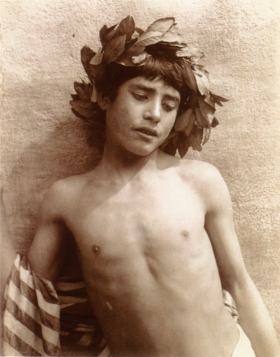 He was eventually formally exonerated of all charges,
returned to duty with his artillery company and, amazingly, was allowed
to resume his correspondence with Wilhelm. He was eventually formally exonerated of all charges,
returned to duty with his artillery company and, amazingly, was allowed
to resume his correspondence with Wilhelm.
At the war's end, Wilhelm and Sofia returned to Taormina without
delay. Il Moro had everything ready -- flowers, fruit, and wine
on the tables, and the studio ready for work. Through tears of
joy, Wilhelm saw the faces of the boys he loved. But he also saw
that some were missing. Later that first day, Wilhelm retired
alone to the locked studio to pore over his many photographs of the
youths he would never see again. Throughout the night, some
residents of the village reported hearing erratic sobs coming from the
locked studio. Wilhelm later told an English friend that the joy
and pain he experienced on that first day of his return had been almost
beyond bearing.
THE YEARS AFTER THE WAR
were prosperous and comfortable. The fame
of this Baron from Taormina continued to attract admirers from all over
the world. The villa and the studio were constantly active.
Sofia
was at Wilhelm's one side, and Il Moro was at his other. The
secret nighttime revels were revived. Although political upheaval
was in the air again, the news reports seldom affected Taormina.
Mussolini rose to power in 1926, but fortunately the changing political
situation never interfered with Wilhelm's final years. Then in
his seventies, Wilhelm was beginning to slow down. He continued
to photograph until 1930, the year before his death. Sofia died
just three months before Wilhelm. They were buried side by side,
surrounded by the land they loved.
Il Moro was named as Wilhelm's inheritor. He received all the
personal possessions and some 3,000 negative glass plates, representing
more than a quarter century of work. Il Moro had no thought of
exploiting the potential financial treasure. People still sought
out photos, but for Il Moro, they were a personal remembrance, and he
guarded their safety fiercely. They remained in trunks, chests,
and cabinets of his humble lodgings -- unreproduced. They were a
tangible link between Wilhelm and his own life.
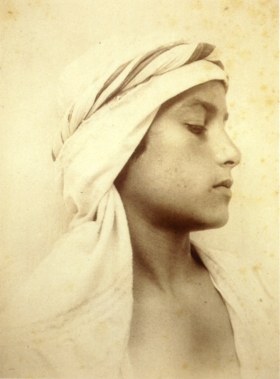 But in 1936, Mussolini's fascist government,
with the aid of the
Catholic church, began a vice campaign. The police raided Il
Moro's home, pounding at the door in the night with no warrant or
warning. He pleaded with the fascists not to damage the fragile
glass plates, but over 1,000 of the irreplaceable negatives were
smashed before him as he wept. Those not destroyed outright were
roughly thrown into crates and carried away as evidence. Many
more were destroyed in the process. Il Moro was once again taken
off to jail because of his association with von Gloeden. This
time he was charged with the possession of pornography. But in 1936, Mussolini's fascist government,
with the aid of the
Catholic church, began a vice campaign. The police raided Il
Moro's home, pounding at the door in the night with no warrant or
warning. He pleaded with the fascists not to damage the fragile
glass plates, but over 1,000 of the irreplaceable negatives were
smashed before him as he wept. Those not destroyed outright were
roughly thrown into crates and carried away as evidence. Many
more were destroyed in the process. Il Moro was once again taken
off to jail because of his association with von Gloeden. This
time he was charged with the possession of pornography.
Il Moro was now in his fifties, a simple man with no formal
education. Yet he was intelligent and possessed considerable
knowledge of the world owing to his lifelong relationship with von
Gloeden and his friends. He was capable of turning his defense
against the charges of pornography into an astonishing defense of the
memory of Wilhelm von Gloeden, and of his life and his art. This
simple man risked contempt of court in a potentially hostile tribunal
in the midst of fascist insanity. He told the court that it was
not within its competence to judge works of art of any kind. As
evidence of the error of the charge of pornography, he listed countless
names of collectors: museums, critics, kings, industrialists and
institutions -- including the Italian Ministry of Education! Il
Moro finished his impassioned statement, and then rested his otherwise
undefended case. Miraculously, the judges concurred! Had
the trial occurred just one year later, after a purge of liberal
judges, Il Moro would likely have spent the remaining years of his life
in prison, and the world would have been deprived of most of von
Gloeden's photographs.
The verdict could not, unfortunately, save the plates which had already
been destroyed. The remaining plates -- less than half of the
original number -- were distributed among and safely hidden by local
families, priests, and scholarly institutions until the end of the
World War II. In the course of these moves, many plates were
lost. When the collection was finally reassembled, it was found
that of the more than 3,000 plates, less than a third survived.
 From the time of his trial
until his death in the 1950s, Pancrazio
Bucini -- Il Moro -- lived quietly in Taormina. The glass plates
remained in private hands, and were largely forgotten. Even after
the war, laws in Italy and Germany, remnants of the former fascist
governments, forbade nudity in photography. Under the pressure of
the Catholic church and the right wing, these laws were allowed to
remain on the books. The ban on buying and selling such
photographic work assured an ongoing suppression of von Gloeden's
vision. But it did not suppress the desire of informed
collectors. Von Gloeden prints were sold out of the back rooms of
art galleries and book shops, much as liquor was sold in the U.S.
during the years of Prohibition. But finally, legal challenges in
the late 1960s and early 1970s allowed the purchase of pictorial nudity
and other so-called pornographic materials. von Gloeden's work
has been slowly reprinted, and is now readily available throughout the
West (including the U.S.). von Gloeden's art is once again
accepted and admired as it was during his own lifetime. These
timeless examples of male beauty inform our lives and
imaginations. The story of their creation reveals a courage and a
confidence of vision that can inspire us towards our own goals. From the time of his trial
until his death in the 1950s, Pancrazio
Bucini -- Il Moro -- lived quietly in Taormina. The glass plates
remained in private hands, and were largely forgotten. Even after
the war, laws in Italy and Germany, remnants of the former fascist
governments, forbade nudity in photography. Under the pressure of
the Catholic church and the right wing, these laws were allowed to
remain on the books. The ban on buying and selling such
photographic work assured an ongoing suppression of von Gloeden's
vision. But it did not suppress the desire of informed
collectors. Von Gloeden prints were sold out of the back rooms of
art galleries and book shops, much as liquor was sold in the U.S.
during the years of Prohibition. But finally, legal challenges in
the late 1960s and early 1970s allowed the purchase of pictorial nudity
and other so-called pornographic materials. von Gloeden's work
has been slowly reprinted, and is now readily available throughout the
West (including the U.S.). von Gloeden's art is once again
accepted and admired as it was during his own lifetime. These
timeless examples of male beauty inform our lives and
imaginations. The story of their creation reveals a courage and a
confidence of vision that can inspire us towards our own goals.
1. Charles Leslie, Wilhelm von
Gloeden:
Photographer.
New York: Soho Photographic Publishers, 1977.
Von Gloeden in print
A NUMBER OF FINE editions of von Gloeden's work are available.
Here is a short list of some titles that have been widely sold in North
America:
Wilhelm von Gloeden Postcard Book. Köln:
Benedikt Taschen Verlag, 1995. ISBN 3822894397
Wilhelm von
Gloeden
Poster Book. Köln: Taschen GmbH, 1994. ISBN 3822894311
Roland Barthes. Taormina:
Wilhelm von Gloeden (3rd edition). Santa Fe: Twin
Palms Publishers, 1998. ISBN: 0942642430
Volker Janssen (ed.). Wilhelm von Gloeden, Wilhelm von
Plüschow, Vincenzo Galdi: Italienische
Jünglings-Photographien um 1900. Berlin: Janssen Verlag,
1991.
Charles Leslie. Wilhelm Von Gloeden Photograper. A Brief
Introduction to His Life and Work. New York: SoHo Photographic
Publishers, 1977. Library of Congress Catalog Card Number
77-83146.
Ulrich Pohlmann. Wilhelm von Gloeden: Taormina. New York: te
Neues
Publishing, 1998. ISBN 3-8238-0365-4
Peter Weiermair. Wilhelm Von Gloeden: Erotic Photographs.
Köln: Taschen Verlag, 1994. ISBN 3-8228-9315-3
Check used and antiquarian booksellers and on-line vendors for other,
out of print titles and editions in other languages.
|
From
GAYME, Vol. 2,
No. 1, Pg. 30-37, Sept. 1994.
|
Copyright ©
NAMBLA, 2008
|
|
|
|
|

